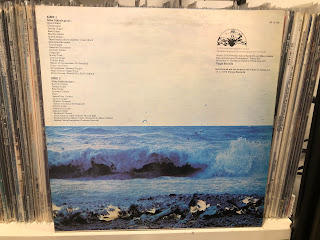My uncle Lloyd had a copy of the album, and all I remember is him playing the record once through the first part of side a, and it was mesmerizing. I can still see him standing by the stereo holding the record in his hands while the opening played. He then casually mentioned that Mike Oldfield played just about everything himself on the album. That stuck with me. I never forgot it. I wanted to be able to do that.
Over the years I never really thought much about Mike Oldfield. His name would pop up again in the early '80s when Hall & Oates hat a hit with "Family Man" and I never really liked Hall & Oates, but that was a cool song. After that it really was decades before I thought of him again.
My kids were watching a lot of anime, and of course Death Note was a big deal and the soundtrack for the show was incredible, and also really really familiar. "Holy craps kids, that's "Tubular Bells!" Which of course garnered me a roll eyes and a so what. Now I was curious, so I went out downloaded the two versions of the album from iTunes. The original version and his re-recorded 2003 version. It was awesome. I was drawn more to the 2003 version initially because unlike the album version that was part one and part two, the remake separated the various tracks, which for me made it easier to digest.
I was rummaging through the bins as there was a sale going on but oddly it was a discount copy of Tubular Bells that caught my attention. It looked to be an original pressing from 1973, which I found to be pretty nifty. The back cover was very simple, no track listing. Just Side One, and Side Two and a long list under each heading a long long list of instruments Mike Oldfield had played on each cut. I was immediately transported back in time, and I was transfixed by ambitious and somewhat pretentious nature of the credits. I mean, seriously you could just write: guitar. Not go on about electric guitar, fuzz guitar, acoustic guitar, still it was pretty awesome.It's been several years since I've actually plonked my ass in a chair and listened to this all the way through. The first thing that really struck me was how ambitious this way. It wasn't a unwieldy collection of half baked ideas delivered by musician who was a jack of all trades and master of none ... this was a fully realized piece of music that was in two parts. Hence Side One ... and then Side Two. As to the vinyl, it was in surprisingly great shape, and aside from a pop or two it played nice and clean which is always a bonus.
Of course if it wasn't for The Exorcist who knows what would have happened with the album. By all accounts Mike Oldfield had a patron in Richard Branson and when he couldn't secure distribution for Mike Oldfield's Opus One he ended up starting Virgin Records and released the album himself. It was slow going at first, but when the movie used his opening as the theme things took off, and the album would stay on the charts for over a year.
What hits me now more than anything is how young Mike Oldfield was at the time, and how singular his vision was to create what he heard in his head. He was only 20 when the album was released and he'd already been working for a number of years in the music field. Crazy. He had a rebellious sense of humour too as the only "vocal" section on the album was credited to Piltdown Man on Side Two, where Mike Oldfield had spent hours screaming himself hoarse while the vocals were recorded and later slowed down to get the desired pitch. All Richard Branson had asked for was a song with vocals that could be potentially pulled as a single.
I think my favourite bit of trivia has to do with the bells themselves. Normally they're struck with a mallet, but it didn't produce the desired intensity ... so he used a claw hammer. While he got the sound he wanted he also cracked the bells in the process.



Comments
Post a Comment